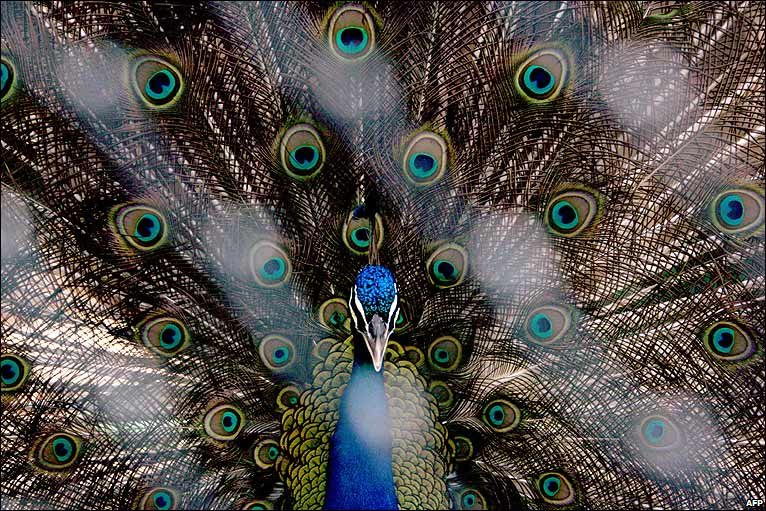How about enjoying some of the magnificent peacock facts for kids including peacock habitat, diet, and reproduction. Peafowls commonly referred to as peacocks, belong to the genus Pavo and the family of Phasianidae. There are around three species of peafowls: common or Indian peafowl, green and blue peafowl, and the Congo peafowl. Of all these, green peafowl inhabits all along the farther east ranging from Myanmar (Burma) to Java. The Indian peafowls have long been admired for being kept in captivity for more than 2,000 years ago. Indian peafowls are the most widespread species that are found mostly in India, Pakistan, and parts of Sri Lanka.
Amazing Peacock Facts For Kids
- The head, neck, and the breast of peacock displays a shiny blue description, relieved only by white blotches, painted above and below the eyes. The peacock’s head is shed by brush-like crested feathers displaying beautiful outlook.
- The peacock’s body is adorned with amazing brown feathers on the back and on the front. Nevertheless, the real beauty lies in its tail exhibiting greenish color which is mainly made up of elongated tail coverts.
- The male is called peafowl while the female is referred to as peahen.
- The weight of the male peacock measures around 8.5 – 13.5 lb (4 – 6 kg), while females weigh around 6 – 8.5 lb (2.75 – 4 kg).
- The peafowls are 6 – 7.5 feet (1.8 – 2.3 meters) in length, while peahens measure around 3 – 3.5 feet (0.9 – 1 meter).
- The length of the peacock measures around 7.5 feet (2.3 meters), including two-third of the tail. Unlike peacock, peahen is less impressive rather she displays whitish face as well as brown crown coupled with the metallic upper breast. Although peahen displays brush-like crest but it surely lacks that sweeping train which males possess.
- No significant difference is observed in the male and female’s plumage of green peafowl, with both displaying tan mottlings running from the crest to the tail.
- The green peafowls present black and turquoise outlook, with the whole plumage exhibiting metallic appearance. The Indian peafowls have larger crest as compared to the green peafowls. Both these peafowls are also known to hybridize in captivity, the offspring looking like the Indian parents.
- Congo peafowl which was not known until 1936 is normally found in deep forests. The male reveals out green and blue color together with a relatively shorter tail, along with a patch of bare red skin. The female, on the other hand, presents coppery green and chestnut appearance. The last time ever Congo peafowl seen was back in 1982 and it most likely to be endangered species.
- The peacock mostly displays during the breeding season.
- The Indian peafowls are known to roost on trees and feed on the ground. They produce loud noises as they approach upwards branch by branch in the late afternoon. These are vociferous creatures in that the shrill noises can be heard sporadically after dark. When peacocks are pursued, they will disappear into the forest woods and avoids confrontation; their plumage offers a natural camouflage to keep them out of sight.
- Peacocks are often found in proximity to the human settlements which is primarily possible when they are unprovoked. This feature marks the difference between them and other domesticated animals as peacocks can be considered as semi-domesticated birds.
- Indian peafowl not only keep to the similar roost and visit the same feeding grounds and sunbathing places day in day out, but the male also has a chosen place for displaying. The entire displaying effect appears to be lost on four or five hens in the peacock’s harem, but finally mating takes place.
- The peacock’s display of its majestic train is portrayed in the ornithological literature as composed of extended tail coverts, fairly decayed with eyespots. The peacock’s feathers are not interlocked with each other.
- These birds are often kept in captivity for religious, aesthetic or sentimental reasons for over 2,000 years.
- The peafowls will expose their fans to any passing by birds, humans or peahens. He seems to strut while displaying and for the same reason the phrase “proud as a peacock” is derived. The tail grows in length as the peafowl’s age proceeds.
- In some parts of the world peacocks are worshipped while in others they are killed for food. The India peafowls are often given protection for religious and sentimental reasons across southern India, and in those areas it turns out to be tame. Where it is still hunted, it remains shy and secretive.
What Do Peacocks Eat
Peafowls are omnivorous and will feed on insects, fruits, grain, seeds, flower petals, seed heads, plants matter, arthropods, reptiles, amphibians, and in gardens, bread and other scraps. Peafowls will exclusively feed on almost anything edible, animals or plants, these birds are often found to prey on even small mammals including mice, vole, and sometime snakes. Peacocks will, like barnyard chicken, snap flies from the air or pursue butterflies.
Reproduction | Peacock Facts For Kids
Indian peafowls often build their nests in trees to avoid predators. It is more often a shallow scrape in the ground where 3 – 6 eggs are usually laid. The eggs are mostly laid in the months ranging from January to March in southern India, but it can sometimes be as late as in September elsewhere. The hatching period lasts for 28 – 30 days. The hen then begins to feed its chicks from her bill, and chicks will instinctively peck.


Leave a Reply